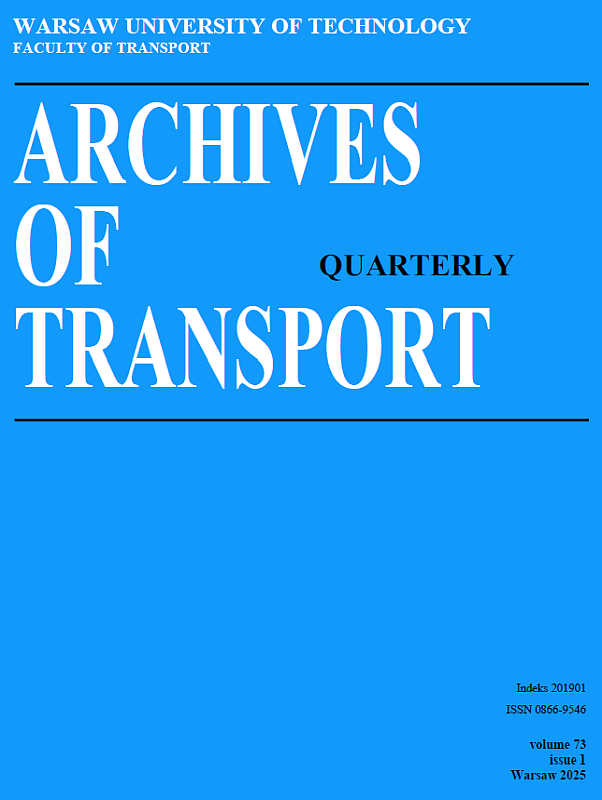Proposal of a new evaluation system of terrain trafficability for wheeled vehicles measured by the telescopic penetrometer
DOI:
https://doi.org/10.61089/aot2025.j9n4vv88Keywords:
mobility, terrain trafficability, passability of wheeled vehicles, penetrometer, trafficability determining systemAbstract
In most areas of human activity where vehicles are used, ensuring their mobility is important. One of the components addressed in the framework of mobility is also the movement of vehicles in the field. The article deals with the assessment of wheeled vehicles' trafficability through low-bearing terrain. Therefore, it is important to be able to reliably evaluate whether the terrain is passable or not, i.e. determining the trafficability of the terrain. Currently, two assessment systems are used in the ACR environment to evaluate the bearing capacity of the terrain – one using a PT-45 telescopic penetro-meter and the other using a cone penetrometer. Each of the systems has its advantages and disadvantages, but unfortunately, none of them meet the current requirements of users. Both methods designed for evaluating the passability of wheeled vehicles on terrain always compare the “value of the land” and the “value of the vehicle”. Based on the advantages and disadvantages of both evaluation methods, the authors decided to find out whether it would be possible to combine the advantages of both methods and propose a new evaluation system for the telescopic penetrometer, based on the evaluation system for the cone penetrometer. The following was carried out: i) comparison of individual devices and assessment procedures, ii) correlation of permeability measurement results obtained using both penetro-meters, iii) analysis of individual vehicle parameters included in existing assessment methods. The authors present the results of the analysis of the parameters, propose their reduction, and introduce a new important parameter, which significantly affects the result, that is, whether the vehicle will pass the terrain. In conclusion, a completely new system for measuring the passability of wheeled vehicles through the terrain was designed. The correctness and reliability of the entire newly designed system was verified by measurements in the field. Due to the fact that the authors proceeded to solve the problem of trafficability on the basis of requirements from the field, its results will have a great practical impact – the implementation of the new evaluation system into the Field Manual used by the ACR.
References
1. Alesso, C. A., Masola, M. J., Carrizo, M. E., & Imhoff, S. D. C. (2017). Estimating sample size of soil cone index profiles by bootstrapping. Revista Brasileira de Ciências do Solo, 41, e0160464. https://doi.org/10.1590/18069657rbcs20160464
2. Alesso, C. A., Cipriotti, P. A., Masola, M. J., Carrizo, M. E., Imhoff, S. C., Rocha-Meneses, L., et al. (2020). Spatial distribution of soil mechanical strength in a controlled traffic farming system as determined by cone index and geostatistical techniques. Agronomy Research, 18(1), 1115–1126. https://doi.org/10.15159/AR.20.133
3. Alesso, C. A., Masola, M. J., Carrizo, M. E., Cipriotti, P. A., & Imhoff, S. D. (2018). Spatial variability of short-term effect of tillage on cone index. Archives of Agronomy and Soil Science. https://doi.org/10.1080/03650340.2018.1532076
4. Borkowska, S., & Pokonieczny, K. (2021). Soil passability analysis in the open terrain. In International Conference on Military Technologies (ICMT), Czech Republic. ISBN (Online): 978-1-6654-3724-0
5. Calderon, L. A., & Piedrahita, C. A. (2019). New Methodology for Inertial Identification of Low Mobility Mechanisms Considering Dynamic Contribution. International Journal of Automotive and Mechanical Engineering, 7341–7363. Universiti Malaysia Pahang, Pahang, Malaysia. https://doi.org/10.15282/ijame.16.4.2019.11.0545
6. McCullough, M., Jayakumar, P., Dasch, J., & Gorsich, D. (2017). The Next Generation NATO Reference mobility model development. Journal of Terramechanics, 49–60. https://doi.org/10.1016/j.jterra.2017.06.002
7. Cibulová, K., & Priesner, M. (2022). Parameters and Influences for an Evaluation System of Trafficability of Vehicles on Terrain. In Challenges to National Defence in Contemporary Geopolitical Situation, Lithuania, (1), 7–16. https://doi.org/10.47459/cndcgs.2022.1
8. Cibulová, K., Hejmal, Z., & Vala, M. (2015). The Influence of the Tires on the Trafficability. International Conference on Military Technologies (ICMT 2015), Czech Republic, 219–222. https://doi.org/10.1109/MILTECHS.2015.7153672
9. Cibulová, K., Priesner, M., & Rolenec, O. (2020). Overcoming Areas Covered by Snow with Perspective Materials. In S. Bekesiene & S. Hoskova-Mayerova (Eds.), Challenges to National Defence in Contemporary Geopolitical Situation (CNDCGS 2020), Lithuania, 52–55. https://doi.org/10.47459/cndcgs.2020.6
10. Cibulová, K., & Sobotka, J. (2019). Utilization of Perspective Materials for Negotiation of Watercourses. Transport Means 2019. Kaunas University of Technology, Palanga, 23, 655–659. ISSN 1822-296X.
11. Cibulová, K., & Sobotka, J. (2017). Testing of Different Ways of Overcoming Untrafficable Terrain. Proceedings of the 2017 International Conference on Military Technologies (ICMT). Institute of Electrical and Electronics Engineers Inc., Piscataway, NJ, 313–317. https://doi.org/10.1109/MILTECHS.2017.7988776
12. Davidson, D. T. (1965). Penetrometer measurements. In A. Klute (Ed.), Methods of soil analysis. Part 1 (2nd ed., Agronomy Monograph 9, pp. 463–478). ASA and SSSA.
13. Di Maria, E., Reina, G., Ishii, K., & Guiannoccaro, N. I. (2021). Rolling resistance and sinkage analysis by comparing FEM and experimental data for a grape transporting vehicle. Journal of Terramechanics, 59–70. https://doi.org/10.1016/j.jterra.2021.06.004
14. Ewing, J., Oommen, T., Jayakumar, P., & Alger, R. (2020). Characterizing Soil Stiffness Using Thermal Remote Sensing and Machine Learning. MDPI - Remote Sensing, 12(4), 15. https://doi.org/10.3390/rs13122306
15. United States Army. (1994). Field manual 5-430-00-1: Planning and design of roads, airfields, and heliports in the theater of operations - Road design.
16. Garba, V. (2020). Calibration design of the PT-45 penetrometer for use in operations (Diploma thesis). University of Defence, Brno, Czech Republic.
17. Goodin, C., Dabbiru, L., Hudson, C., Mason, G., Carruth, D., & Doude, M. (2020). Fast terrain traversability estimation with terrestrial lidar in off-road autonomous navigation. Unmanned Systems Technology XXIII. https://doi.org/10.1117/12.2585797
18. Hasilová, K., Otřísal, P., & Stodola, P. (2023). Smoothing Methods for Continuous Permeation Data Measured Discretely Designated for Quick Evaluation of Barrier Materials. Advances in Military Technology, 18(2), 207–222. https://doi.org/10.3849/aimt.01826
19. Huang, W., Wong, J. Y., Preston-Thomas, J., & Jayakumar, P. (2020). Predicting terrain parameters for physics-based vehicle mobility models from cone index data. Journal of Terramechanics, 29–40. https://doi.org/10.1016/j.jterra.2019.12.004
20. Jayakumar, P., & Wasfy, T. (2021). Next-generation NATO reference mobility model complex terramechanics – Part 1: Definition and literature review. Journal of Terramechanics, 96, 45–57. https://doi.org/10.1016/j.jterra.2021.02.002
21. Jayakumar, P., & Wasfy, T. (2021). Next-generation NATO reference mobility model complex terramechanics – Part 2: Requirements and prototype. Journal of Terramechanics, 96, 59–79. https://doi.org/10.1016/j.jterra.2021.02.007
22. Kozłowski, E., Borucka, A., Oleszczuk, P., & Jałowiec, T. (2023). Evaluation of the maintenance system readiness using the semi-Markov model taking into account hidden factors. Eksploatacja i Niezawodnosc – Maintenance and Reliability, 25(4). http://doi.org/10.17531/ein/172857
23. Kurfiřt, J. (2014). Analysis of the degree of influence of the types of tyres used on off-road passability (Diploma thesis). University of Defence, Brno, Czech Republic.
24. Liu, Y., Jiang, C., Mourelatos, Z. P., Gorsich, D., & Jayakumar, P. (2020). Simulation-Based Mission Mobility Reliability Analysis of Off-Road Ground Vehicles. Mechanical Design, 143–158. https://doi.org/10.1115/1.4048314
25. Lee, J. S., Kim, S. Y., Hong, W. T., & Byun, Y. H. (2019). Assessing subgrade strength using an instrumented dynamic cone penetrometer. Soils and Foundations, 59, 930–941. https://doi.org/10.1016/j.sandf.2019.03.005
26. Mahonen, J., Lientzén, N., & Casselgren, J. (2021). Portable bevameter for measuring snow properties in the field. Cold Regions Science and Technology. https://doi.org/10.1016/j.coldregions.2020.103195
27. Malik, A. S., Kumar, R. J., & Rahman, H. (2020). Mobility Performance Prediction Model for Main Battle Tanks. International Conference on Advances in Design, Materials, Manufacturing and Surface Engineering for Mobility. https://doi.org/10.4271/2020-28-0355
28. Mason, G. L., Vahedifard, F., Caster, T. J., & Priddy, J. D. (2022). A unified equation for predicting gross traction for wheels on clay over a range of braked, towed, and powered operations. Journal of Terramechanics, 104, 1–13. https://doi.org/10.1016/j.jterra.2022.08.002
29. Mason, G. L., Salmon, J. E., McLeod, S., Jayakumar, P., Cole, M. P., & Smith, W. (2020). An overview of methods to convert cone index to bevameter parameters. Journal of Terramechanics, 87, 1–9. https://doi.org/10.1016/j.jterra.2019.10.001
30. Mechergui, D., & Jayakumar, P. (2020). Efficient generation of accurate mobility maps using machine learning algorithms. Journal of Terramechanics, 88, 53–63. https://doi.org/10.1016/j.jterra.2019.12.002
31. Moraes, M. T., Silva, V. R., & Zwirtes, A. L. (2014). Use of penetrometers in agriculture: A review. Engenharia Agrícola, 179–193. https://doi.org/10.1590/S0100-69162014000100019
32. Oh, J., Nam, J.-S., Kim, S., & Park, Y.-J. (2019). Influence of tire inflation pressure on the estimation of rating cone index using wheel sinkage. Journal of Terramechanics, 84, 13–20. https://doi.org/10.1016/j.jterra.2019.04.002
33. Parker, M., Stott, A., Bodie, M., Frankenstein, S., & Shoop, S. (2021). Vehicle mobility on highly organic soils. Journal of Terramechanics, 98, 16–24. https://doi.org/10.1016/j.jterra.2021.09.001
34. Prikner, P., Grečenko, A., & Prazan, R. (2017). Application of tire rating with the aim to implement the matter on agricultural tires. 19th International and 14th European-African Regional Conference of the ISTVS, Hungary.
35. Pundir, S. K., & Garg, R. D. (2021). Development of an empirical relation to assess soil spatial variability for off-road trafficability using terrain similarity analysis & geospatial data. Remote Sensing Letters, 12(3), 259–268. https://doi.org/10.1080/2150704X.2021.1880657
36. Pundir, S. K., & Garg, R. D. (2022). A comprehensive approach for off-road trafficability evaluation and development of modified equation for estimation of RCI to assess regional soil variation using geospatial technology. Quaternary Science Advances 5. https://doi.org/10.1016/j.qsa.2021.100042
37. Rybansky, M. (2020). Determination of the ability of military vehicles to override vegetation. Journal of Terramechanics, 91, 129–138. https://doi.org/10.1016/j.jterra.2020.06.004
38. Shenvi, M. N., Sandu, C., & Untaroiu, C. (2022). Review of compressed snow mechanics: Testing methods. Journal of Terramechanics 100, 25–37. https://doi.org/10.1016/j.jterra.2021.11.006
39. Sládek, D., & Kolář, P. (2023). Assessing the Quality of Non-Professional Meteorological Data for Operational Purposes. Advances in Military Technology, 18(2), 275–289. https://doi.org/10.3849/aimt.01781
40. Vahedifard, F., Williams, J. M., Mason, G. L., Howard, I. L., & Priddy, J. D. (2017). Development of a multi-year database to assess off-road mobility algorithms in fine-grained soils. Journal of Vehicle Performance, 3–18. https://doi.org/10.1504/IJVP.2017.081259
41. Vennik, K., Kukk, P., Krebstein, K., Reintam, E., & Keller, T. (2018). Measurements and simulations of rut depth due to single and multiple passes of a military vehicle on different soil types. Soil and Tillage Research, 186, 120–127. https://doi.org/10.1016/j.still.2018.10.011
42. Wasfy, T., Wasfy, H., Jayakumar, P., & Sanikommu, S. (2020). Finite element model for prediction of ground vehicle mobility over vegetation covered terrains. In ASME 2020 International Design Engineering Technical Conferences and Computers and Information in Engineering Conference.
43. Wasfy, T. M., Jayakumar, P., Mechergui, D., & Sanikommu, S. (2018). Prediction of vehicle mobility on large-scale soft-soil terrain maps using physics-based simulation. International Journal of Vehicle Performance, 347–381. https://doi.org/10.1504/IJVP.2018.095753
44. Wieder, W. L., & Shoop, S. A. (2018). State of the knowledge of vegetation impact on soil strength and trafficability. Journal of Terramechanics 78, 1–14. https://doi.org/10.1016/j.jterra.2018.03.006
45. Wiejak, G., Grzelak, M., & Mroczek, R. (2023). Rating of the Mobility of Military Logistic Vehicles Used in the Polish Armed Forces. Advances in Military Technology, 18(1), 79–86. https://doi.org/10.3849/aimt.01788
46. Williams, J. M., Vahedifard, F., Howard, I. L., Borazjani, A., Mason, G. L., & Priddy, J. D. (2019). Mobility guidance for tracked vehicles on fine-grained soil from historical full-scale test data in DROVE 2.0. Journal of Terramechanics 84, 1–12. https://doi.org/10.1016/j.jterra.2019.04.003
47. Wong, J. Y., Jayakumar, P., Toma, E., & Preston-Thomas, J. (2020). A review of mobility metrics for next-generation vehicle mobility models. Journal of Terramechanics 87, 11–20. https://doi.org/10.1016/j.jterra.2019.10.003
48. Wright, K. R., Botha, T. R., & Els, P. S. (2019). Effects of age and wear on the stiffness and friction properties of an SUV tyre. Journal of Terramechanics 84, 21–30. https://doi.org/10.1016/j.jterra.2019.04.001
49. Zhukov, S. S., Makarov, V. S., & Belyakov, V. V. (2020). Method of development of snow mobility maps. Journal of Physics: Conference Series. https://doi.org/10.1088/1742-6596/1753/1/012028
50. Ministry of Defence. (1987). Žen 2-16 Military roads and ways.
Downloads
Published
Data Availability Statement
Data are available on reguest.
Issue
Section
License
Copyright (c) 2025 Archives of Transport journal allows the author(s) to hold the copyright without restrictions.

This work is licensed under a Creative Commons Attribution 4.0 International License.










